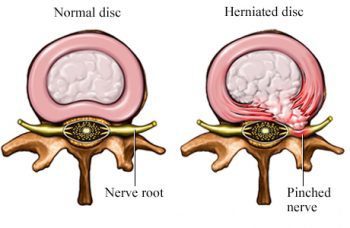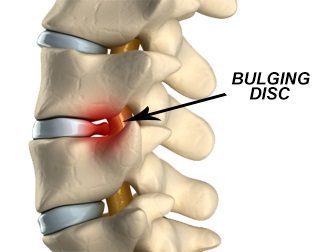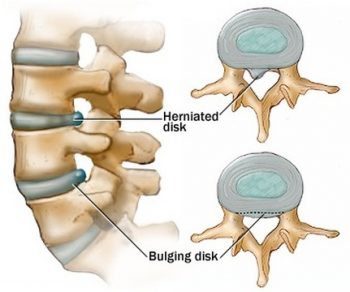Back pain is one of the most common symptoms reported by the majority of the population, often as a result of a variety of injuries or conditions. Almost everyone has felt this type of pain and discomfort at some point in their lifetimes and for those suffering from the painful symptoms, performing normal, daily activities can become difficult and impairing. If the individual is experiencing constant, worsening back pain, however, the source of their symptoms could be more serious, such as a disc herniation or disc bulge.
The spine is a complex structure consisting of many vertebrae which are stacked upon one another and each of these bones are separated by spinal discs. The vertebral disc in the spine primarily function as a shock absorber between the adjacent vertebrae. Spinal discs also act as ligaments to hold the vertebrae of the spine together and as cartilaginous joints which allow for slight mobility in the spine.
Each disc is composed of two parts: the annulus fibrosus, a tough, circular outer portion which surrounds the inner core, and the nucleus pulposus, the soft, inner core consisting of a loose network of fibers. The structure of a healthy, vertebral disc is compared to that of a jelly doughnut. The complex composition of each disc evenly distributes the force and pressure which is applied on the spine. At birth, approximately 80 percent of the discs are composed of water and these must be well hydrated to function properly. However, as people age, the structures of the spine, including the discs, go through a natural process of degeneration which is generally the leading cause for disc complications.
Table of Contents
Herniated Disc Vs Bulging Disc
As individual’s age, the spinal discs begin to dehydrate and become stiffer and fragile, causing the disc to be less able to adjust to compression and stress. While this is a normal process, the stage may be painful for some individuals and can ultimately cause a disc herniation, disc bulge and other issues within the discs of the spine.
A disc herniation is identified when the nucleus in the center of the disc pushes or protrudes partially or completely through the annulus and squeezes out of the disc. A disc herniation or a disc protrusion are two words used to describe the same condition. When a disc herniates, the contents may spread out to the spinal cord and spinal nerves, often compressing these structures and causing a variety of symptoms. The impingement of the nerves can irritate the nerves surrounding the disc herniation, causing swelling and pain. In addition, when a vertebral disc protrudes through the annulus, the chemicals found within the disc’s gel-like nucleus can cause irritation and swelling as well.

A disc bulge is characterized by a deformation of the annulus where the disc is not necessarily herniated. When a disc bulges or prolapses outward, the nucleus presses against the wall of the disc but the material is still contained within the disc without squeezing through the annulus.

Additionally, a disc bulge can cause just as much complications as a disc herniation where the vertebral disc may still push against the spinal canal and its other structures while not breaking the disc open. The disc remains intact except a small bubble pops out attached to the disc.
En Espanol
Disc Herniation and Disc Bulge Symptoms
A disc herniation or a disc bulge generally develops along the lumbar spine or lower back, although these can also occur in the neck, or cervical spine. Many individuals can have spinal and disc complications without being aware of them as sometimes, no symptoms may be present when there are disc issues. In most cases, the disc itself is not the source of the pain but a nerve compression or impingement caused by a herniated or bulging disc can develop the variety of symptoms.
If the disc complication is located along the individual’s lower back, the pain and discomfort can usually be felt in the buttocks, thigh and calf. This can also involve part of the foot. If the individual’s disc complications are located in the region of the cervical spine, the symptoms of pain can be experienced along the shoulder and arm. The pain and discomfort associated with a pinched nerve caused by a disc herniation or disc bulge can usually worsen with certain movements of the spine.
Because these disc complications compress the nerves of the spine, many individual’s affected by the conditions report feeling numbness and tingling sensations in the region of the body where the affected nerves are located. Ultimately, when an individual is experiencing symptoms of sciatica, it’s recommended to properly diagnose the source of the pain and discomfort as these can also occur if there’s a presence of a disc herniation or a disc bulge which may be compressing the nerves along the lower back.
Furthermore, the muscles and other tissues surrounding the area of the disc herniation or disc bulge can also be affected by the impingement of the nerves in the region, leading to muscle weakness. Depending on the affected muscles, individual’s affected by the conditions may stumble constantly or their ability to lift and hold items may become impaired.

Causes for Disc Complications
A disc herniation or a bulging disc can develop as a result of the spine’s natural degeneration with age, in rare cases, lifting large, heavy objects can lead to spinal complications as well as twisting and turning while lifting, Additionally, trauma from an injury, such as a fall or a blow to the back, can rarely cause a disc herniation or a disc bulge.
 Albeit the process of aging and the normal course of degeneration the spine and the rest of the body undergoes is unavoidable, a disc herniation or a disc bulge can, in many cases, be prevented with several simple steps to reduce the risk of a spinal issue. Exercising regularly and maintaining a healthy weight can both slow the degeneration of the discs by adding strength to the muscles to help stabilize the spine while avoiding excessive strain on the back. Also, maintaining a proper posture and avoiding heavy lifting can relieve the back of any unnecessary stress to ultimately avoid damaging or injuring the complex structures of the spine. Chiropractic care can also help maintain the overall health of the spine. Through the use of spinal adjustments and manual manipulations, a chiropractor can correct a spinal misalignment, restoring the original structure of the spine and reducing symptoms as well as preventing spinal complications due to spinal degeneration.
Albeit the process of aging and the normal course of degeneration the spine and the rest of the body undergoes is unavoidable, a disc herniation or a disc bulge can, in many cases, be prevented with several simple steps to reduce the risk of a spinal issue. Exercising regularly and maintaining a healthy weight can both slow the degeneration of the discs by adding strength to the muscles to help stabilize the spine while avoiding excessive strain on the back. Also, maintaining a proper posture and avoiding heavy lifting can relieve the back of any unnecessary stress to ultimately avoid damaging or injuring the complex structures of the spine. Chiropractic care can also help maintain the overall health of the spine. Through the use of spinal adjustments and manual manipulations, a chiropractor can correct a spinal misalignment, restoring the original structure of the spine and reducing symptoms as well as preventing spinal complications due to spinal degeneration.
For more information, please feel free to ask Dr. Jimenez or contact us at 915-850-0900 .
Preventing Spinal Degeneration
Sourced through Scoop.it from: www.elpasochiropractorblog.com
By Dr. Alex Jimenez
Post Disclaimer
Professional Scope of Practice *
The information on this blog site is not intended to replace a one-on-one relationship with a qualified healthcare professional or licensed physician and is not medical advice. We encourage you to make healthcare decisions based on your research and partnership with a qualified healthcare professional.
Blog Information & Scope Discussions
Welcome to El Paso's Premier Wellness and Injury Care Clinic & Wellness Blog, where Dr. Alex Jimenez, DC, FNP-C, a board-certified Family Practice Nurse Practitioner (FNP-BC) and Chiropractor (DC), presents insights on how our team is dedicated to holistic healing and personalized care. Our practice aligns with evidence-based treatment protocols inspired by integrative medicine principles, similar to those found on this site and our family practice-based chiromed.com site, focusing on restoring health naturally for patients of all ages.
Our areas of chiropractic practice include Wellness & Nutrition, Chronic Pain, Personal Injury, Auto Accident Care, Work Injuries, Back Injury, Low Back Pain, Neck Pain, Migraine Headaches, Sports Injuries, Severe Sciatica, Scoliosis, Complex Herniated Discs, Fibromyalgia, Chronic Pain, Complex Injuries, Stress Management, Functional Medicine Treatments, and in-scope care protocols.
Our information scope is limited to chiropractic, musculoskeletal, physical medicine, wellness, contributing etiological viscerosomatic disturbances within clinical presentations, associated somato-visceral reflex clinical dynamics, subluxation complexes, sensitive health issues, and functional medicine articles, topics, and discussions.
We provide and present clinical collaboration with specialists from various disciplines. Each specialist is governed by their professional scope of practice and their jurisdiction of licensure. We use functional health & wellness protocols to treat and support care for the injuries or disorders of the musculoskeletal system.
Our videos, posts, topics, subjects, and insights cover clinical matters and issues that relate to and directly or indirectly support our clinical scope of practice.*
Our office has made a reasonable effort to provide supportive citations and has identified relevant research studies that support our posts. We provide copies of supporting research studies available to regulatory boards and the public upon request.
We understand that we cover matters that require an additional explanation of how they may assist in a particular care plan or treatment protocol; therefore, to discuss the subject matter above further, please feel free to ask Dr. Alex Jimenez, DC, APRN, FNP-BC, or contact us at 915-850-0900.
We are here to help you and your family.
Blessings
Dr. Alex Jimenez DC, MSACP, APRN, FNP-BC*, CCST, IFMCP, CFMP, ATN
email: coach@elpasofunctionalmedicine.com
Licensed as a Doctor of Chiropractic (DC) in Texas & New Mexico*
Texas DC License # TX5807
New Mexico DC License # NM-DC2182
Licensed as a Registered Nurse (RN*) in Texas & Multistate
Texas RN License # 1191402
ANCC FNP-BC: Board Certified Nurse Practitioner*
Compact Status: Multi-State License: Authorized to Practice in 40 States*
Graduate with Honors: ICHS: MSN-FNP (Family Nurse Practitioner Program)
Degree Granted. Master's in Family Practice MSN Diploma (Cum Laude)
Dr. Alex Jimenez, DC, APRN, FNP-BC*, CFMP, IFMCP, ATN, CCST
My Digital Business Card


